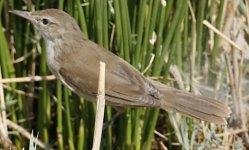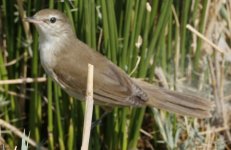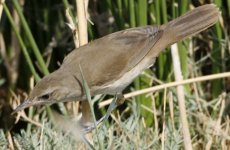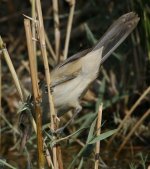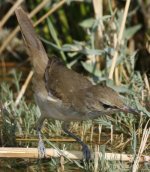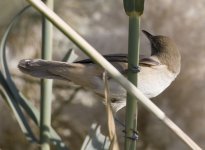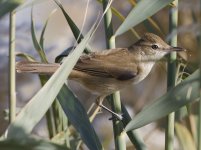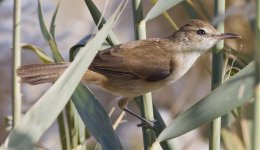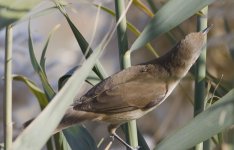Clamorous Reed Warbler
Hello Hannu, JanJ, Sean and all,
I still think the bird in post #8 is Clamorous Reed Warbler, I saw the bird in the reed, was definitely a large bulky bird, shakes the reed stems as it moves through. It is of the
ssp. brunnescens. This ssp. described by K. Baker in "Warblers of Europe ...." as having upperparts more olive-grey than those of nominate form, and
whiter below with only faint buffish suffusion to flanks.
Compared to Great Reed Warbler Baker says: Clamorous, of the subspecies
A. S. brunnescens , may be difficult, sometimes impossible, to separate from worn Great Reed Warbler (especially subspecies A. a. zarudnyi). Generally,
A. S. brunnescens is paler olive-brown or greyish-olive on the upperparts and is paler and
whiter below, with a smaller area of greyish olive-buff to sides of body. However, plumage tone differences between the two species are very marginal. Nevertheless, the reduced,
shorter,
whiter supercilium,
slightly longer and thinner bill,
shorter primary projection (two-thirds of tertial length, as opposed to about equall length),
with 6-7 primary tips visible beyond tertials, and
slightly longer looking and
more graduated tail are best features to use in establishing identification.
Also Baker adds this when comparing nominate Clamorous with Great Reed: Also, Clamorous has longer, slimmer,
more finely pointed, and slightly decurved bill; more rounded end to tail;.
When compared with Basra, Baker says:
A. S. brunnescens is rather darker and more olivaceous above than nominate, and approaches the tone of Basra Reed. Basra, however, has a
much slimmer bill, a shorter
and squarer tail, and
much more pronounced primary projection, being one third longer than A. S. brunnescens (about equal to tertial length). The face markings are stronger than those of Clamorous Reed, with well-developed white supercilium which
contrast with dark eye-stripe and dark lore.
Also from Baker, the moult of Blyth's Reed Warbler: Apparently northern population may not moult at all untill wintering areas reached, whereas those in southern breeding range undertake quite extensive head and body moult, mid July to early August, finishing mid or late August. Moult suspended shortly before migration and continued soon after arrival in northern India, early August to mid September, completed by mid October or November.
I think the bird in post #1 is Blyth's Reed Warbler in moult stage, a bird from southern population still undergoing post-breeding moult (25 August the date of photograph). This moult makes the bird look unusual. I saw the bird from c25m, thought it was European Reed Warbler because of size.
Compare the Blyth's Reed from India, a bird from northern population probably in active moult, in December and see it looks similar to the bird of post #1.
The following link shows a Blyth's Reed Warbler wintering in India, click next to see more photographs.
http://www.orientalbirdimages.org/s...=1&PHPSESSID=320598eb659b937ca21ccb9fcccb8fdc
BTW. the bird in post #8 was photographed at Jahra East Outfall.
Best wishes,
Alsirhan




